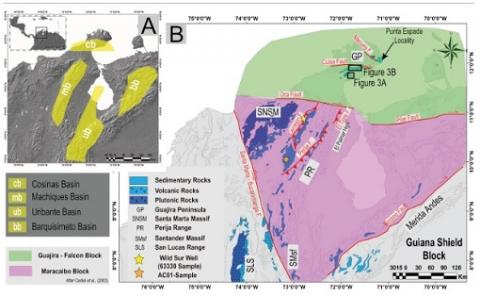Giovanny Nova, Germán Alonso Bayona Chaparro, Juan Carlos Silva-Tamayo, Agustín Cardona, Augusto Rapalini, Paola Catalina Montaño Cortes, Anton Eisenhauer, Karol Tatiana Dussan, Victor A. Valencia, Víctor Ramirez, Camilo Montes
2 019
Journal of South American Earth Sciences Volume 89, January 2019, Pages 92-117
Jurassic extensional basins developed along the northwestern margin of South America during the break-up of Pangea. Presently, these basins are dispersed in several tectonic blocks of the northern Andes and Mexico, hindering reconstruction of western equatorial Pangea before break-up. This is the case of the Cosinas Basin (Guajira block) and the Machiques Basin (Perijá Range), in northern Colombia, which are filled by Jurassic sedimentary and volcano-sedimentary successions. Autochthonous and para-autochthonous hypotheses on the origin of this basins have been proposed. The purpose of this research is to document the sedimentological evolution, depositional age (Sr-isotope + U-Pb geochronology), sediment provenance and paleogeography of the Cosinas and Machiques basins in order to constrain whether these basins formed within a single extensional margin or they formed as extensional basins in different tectonic blocks. Volcanic detrital zircon U-Pb ages documented in La Quinta Formation in the Machiques Basin and at the base of Rancho Grande Formation in the Cosinas Basin suggest that extensional basins were active in Early Jurassic time. However, a significant difference exists in their subsequent history. Whereas in the Machiques Basin dominates the accumulation of Lower and Middle Jurassic volcanoclastic deposits with abrupt lateral thickness changes, accumulation in the Cosinas Basin is dominantly of siliciclastic strata, with the record of two major marine incursions in Late Jurassic time. Integration of provenance results indicates that the Santander Massif supplied sediments to the Machiques Basin. In contrast, Middle to Upper Jurassic sandstones of the Cosinas Basin document unroofing of basement blocks that include metamorphic, sedimentary and plutonic rocks from the Guajira and Maya blocks. The similarity in age and composition of pre-Jurassic rocks in northwestern South America and the so-called peri-Gondwana blocks in the Mexican subcontinent (i.e., Maya and Oaxaquia blocks) challenge the use of detrital zircon population as an indicator of the autochthonous or para-autochthonous origin of the Guajira block. Large uncertainty of paleomagnetic results, and the lack of constraints for the time magnetization acquisition preclude estimating paleolatitudes for the Guajira block in Jurassic time but support previous interpretation of ca. 70°-90° clockwise rotation of the Guajira block relative to stable South America craton. Our preferred paleogeography considers that the Cosinas and Machiques basins were close to each other along the western continental margin of Pangea during the onset of extension in Early Jurassic time. The change from continental to marine depositional environments in Middle to Late Jurassic time along the Cosinas Basin, which have not been identified in the Machiques Basin or other autochthonous Jurassic basins in northwestern South America, allow us to propose that these blocks were separated during the Callovian - Tithonian interval, with the Cosinas Basin remaining closer to a conjugate Mexican margin, that we interpret as the Maya block. Collision of the Guajira block with the South American margin occurred near the Jurassic-Cretaceous boundary, as documented by deformation of Jurassic units previous to deposition of Berriasian strata in the Guajira block.

